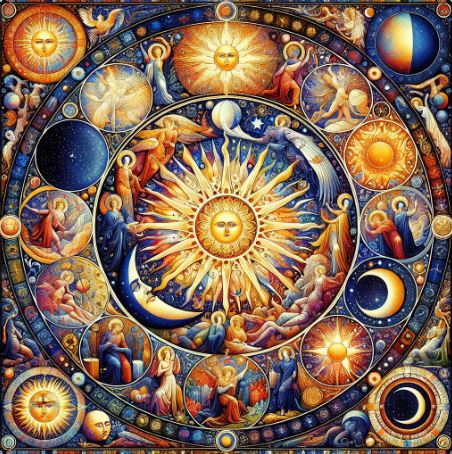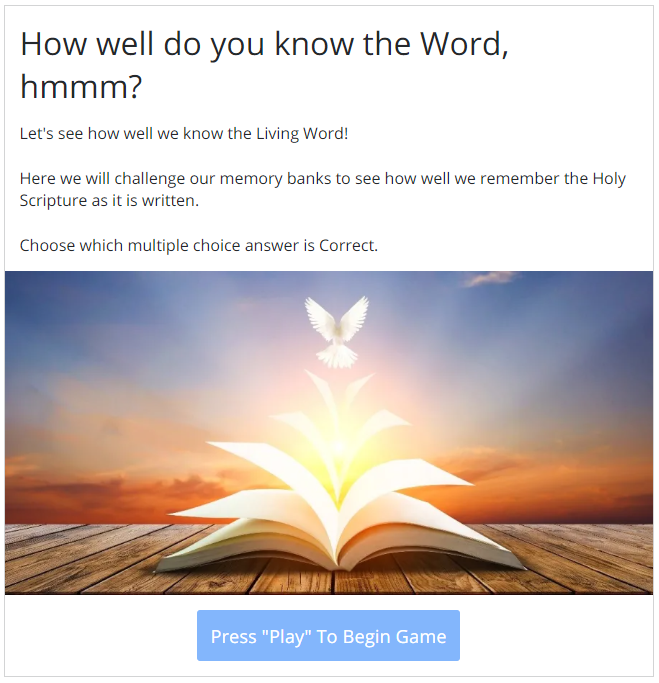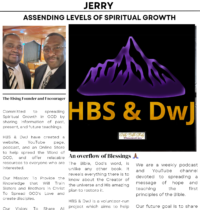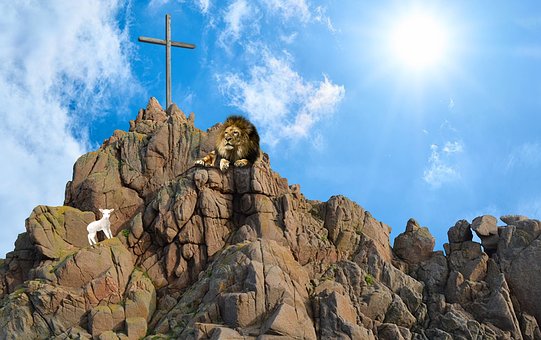God didn’t create the sun and the moon at this time. They were already up there. God just brought them around into position.
The atmosphere being completely purified, the sun, moon, and stars were for the first time unveiled in all their glory in the cloudless sky; and they are described as “in the firmament” which to the eye they appear to be, though we know they are really at vast distances from it.
In the fourth day’s work, the creation of the sun, moon, and stars is accounted for. All these are the works of God.
The stars are spoken of as they appear to our eyes, without telling their number, nature, place, size, or motions; for the Scriptures were written, not to gratify curiosity, or make us astronomers, but to lead us to God, and make us saints.
The lights of heaven are made to serve Him; they do it faithfully, and shine in their season without fail.
We are set as lights in this world to serve God; but do we in like manner answer the end of our creation?
We do not: our light does not shine before God, as His lights shine before us. We burn our Master’s candles, but do not mind our Master’s work.
Genesis 1:14-19 KJV
[14] And God said, Let there be lights in the firmament of the heaven to divide the day from the night; and let them be for signs, and for seasons, and for days, and years:
[15] And let them be for lights in the firmament of the heaven to give light upon the earth: and it was so.
[16] And God made two great lights; the greater light to rule the day, and the lesser light to rule the night: he made the stars also.
[17] And God set them in the firmament of the heaven to give light upon the earth,
[18] And to rule over the day and over the night, and to divide the light from the darkness: and God saw that it was good.
[19] And the evening and the morning were the fourth day.
Genesis 1:14
And God said, Let there be lights in the firmament of the heaven to divide the day from the night; and let them be for signs, and for seasons, and for days, and years:
As with the other days of creation, this one, the fourth, begins with God speaking. Having created “light” (singular) on the first day, God now creates lights. These are physical objects that serve specific purposes.
For them to divide the day from the night speaks to the need for cyclical illumination of the earth. This illumination goes hand in hand with the lights’ being signs: things that attest to divine power at work.
The idea is to give credit to God for His active role in the world. This is the word used to state the significance of the rainbow, given as a sign in the sky that God will not again destroy the earth by a flood.
While there might be the occasional extraordinary sign, the ordered nature of earthly cycles is a daily reminder of God’s provision and presence. Beyond the signs, we now see three derivative manifestations of God’s order.
First, the celestial lights also give us seasons. We may naturally think of seasons in terms of spring, summer, fall, and winter.
That idea may be included, but the idea as it develops throughout the Old Testament is more along the lines of time periods longer than 24 hours in general and the religious festivals of Israel’s calendar in particular.
These become appointed times as determined by phases of the moon. Hand in hand with such periods of time are the days and years. These are the familiar periods of 24 hours and 365 days, respectively.
The yearly cycle is what gives us the seasons of fall, winter, spring, and summer (or, in some areas, the rainy season and the dry season).
All these provide order and regularity. We are created to thrive within this system. For example, astronauts who leave the earth still try to regulate their activities in 24-hour cycles. God has designed a world to fit us and created us to fit His world.
Regardless of translation, verses 14 through 18 can seem somewhat awkward in English. These words were originally written in Hebrew, and under a highly structured repeating pattern.
And yet, the core point of these verses is impossible to miss: God made all the heavenly bodies, ascribed to the fourth day of His creation week.
For the original readers of Scripture, this countered the widespread belief that stars, comets, and the sun were themselves divine.
By clearly showing God’s creation and control, Genesis dispels the idea that there are any true gods other than God.
Days four, five, and six of the Genesis creation week correspond to days one, two, and three. That is, what God creates in each of these last three days is placed in the setting He created on the corresponding earlier day.
In this case, on day one, God used His creative words to form light. This verse describes day four, where God commands that there exist “lights in the expanse of the heavens,” or in the “vault of the sky.”
The following verses will explain that these “lights” are the sun, moon, and stars.
This raises what some see as a difficult question: How did God create light and day and night on the first day (Genesis 1:3–4) if He had not yet created the sun?
It’s a reasonable question, and we don’t have a perfect answer. The easiest explanation is that God caused light to exist apart from the source of sun and stars until those were created, something clearly within His power.
Another option is that these words describe the first time that the sun, moon, and stars became visible on earth, possibly due to a vapor canopy or clouds. Some scholars offer further alternative explanations.
One interesting point of note is that secular science, per the “Big Bang Theory,” actually supports this order of light, then stars.
According to that model, the universe was filled with photons—light particles—long before there were stars or planets.
Whether or not this has a meaningful connection to this part of Genesis, the point is that light preceding stars is not only scientifically possible, modern science claims that was actually the case!
In any event, Scripture does not provide specific details here, meaning they are irrelevant to the point at hand. The main idea of this verse is to describe God’s purpose for these lights, according to His command.
They were to separate day from night, as well as to serve as signs of days, years, and “seasons,” which in this context refers to sacred times.
It is clear that God intended from the beginning for the earth and the solar system to move according to a regular pattern. He meant for days, years, and seasons to be orderly, measurable, and predictable.
Genesis 1:15
And let them be for lights in the firmament of the heaven to give light upon the earth: and it was so.
One of them was to take charge of the day, and the sun does that pretty well. Also the moon does a good job by night. We should catch a little of the wonder and awe of the ancient author here.
He understands the value and purpose of light (created on day one), of heavenly lights (created on day four), and of the need for light upon the earth. We are created to be creatures of light, both physically and spiritually.
The more science learns about sunlight, the more we realize our dependence on it for life. Without the God-provided light that bathes our world on a regular basis, we would lead a sad existence—if any existence at all.
The lighting of our world is a testimony to God’s love and care for us. It is an exciting comparison, then, for Jesus to take the role of “light of the world” (John 8:12), God’s loving answer to our spiritual darkness.
This verse concludes the statement begun in the previous verse. In this passage, God completes His command to create the sun, moon, and stars, on day 4 of creation.
In verse 14, God commanded lights to appear in the heaven—meaning the sky. The purpose of these lights, according to God, is to serve several purposes: to separate day from night, to mark the days, years, and seasons and, in this verse, to provide light upon the earth.
This demonstrates the common pattern of Genesis chapter 1. Each of the first three days prepares a setting, while each of the second three days populates that setting.
On the first day of creation, God created light. On day four, He creates specific sources of daily and nightly light upon the earth.
As mentioned earlier, the idea of light existing prior to the sun and stars seems backwards, but according to modern science it’s not so far-fetched.
Regardless of how one reads this verse, it concludes with four unmistakable and remarkable words: “and it was so.” This uses the Hebrew phrase wa yehi kēn.
This is an almost comically simple way of explaining something as awesome as the creative power of God: He spoke, and the sun, moon, and stars came into being.
The prior verse says God intended our view of the universe to be used for timekeeping.
Psalm 19 tells us that the heavens above us serve another purpose: to declare God’s glory, to proclaim in what He has made the Creator’s magnificence.
Both Psalm 19 and Romans 1 insist no language is necessary to see the glory of God from what He has made.
Genesis 1:16
And God made two great lights; the greater light to rule the day, and the lesser light to rule the night: he made the stars also.
The created order has three classifications of observable heavenly lights.
First we have the greater light, the sun, which rules the day. This does not imply that the sun comes out when there is daylight. Rather, it’s the other way around: the sun defines and causes the day.
Likewise, the lesser light, the moon, defines a darker period, the night. Nights are not without some light, given the shadows we observe when the moon is bright.
Even on nights of a new moon, the stars provide light, although dimly. While we see God’s intentional patterns in creation here, we should also notice that the descriptions are observational, from the perspective of the author or any other human.
It is silly to criticize this portrayal by saying that some of the stars we see are far bigger and brighter than our sun. It doesn’t appear that way from the author’s viewpoint, nor from any other unaided human viewpoint today.
Stars are tiny in the amount of light they shed on the earth. This is the point.
In consequence of the day being reckoned as commencing at sunset – the moon, which would be seen first in the horizon, would appear “a great light,” compared with the little twinkling stars.
While its pale benign radiance would be eclipsed by the dazzling splendor of the sun.
When his attractive and impressive through being richly colorful or sumptuous orb rose in the morning and gradually attained its meridian blaze of glory, it would appear “the greater light” that ruled the day.
Both these lights may be said to be “made” on the fourth day – not created, indeed, for it is a different word that is here used, but constituted, appointed to the important and necessary office of serving as luminaries to the world, and regulating by their motions and their influence the progress and divisions of time.
Verses 14-19 describe the fourth day of the creation week, during which God created the sun, moon, and stars.
Following the usual pattern, prior verses related God’s words, followed in this verse by a description of that command becoming reality.
The sun and moon are pictured as two great lights, one each to govern—or “rule”—the day and the night. At the time Genesis was written, many cultures worshipped the sun, moon, and stars as if they themselves were gods.
The claim of the Bible is that these “lights” are not deities, merely created things made by the one, true God. It’s an idea that still stands in opposition to many cultural norms.
This would have been especially meaningful to the people of Moses’ day, when nations such as Egypt were dominated by belief in gods of the sun, moon, stars, and skies.
This verse ends with another profound understatement: God made the stars. Given what we know of the immense universe surrounding us, this is an incredible display of power.
The idea that God created the whole expanse of our universe in a day, with a word, should astound and humble us.
Not only does our view of the heavens help us track time (Genesis 1:14), it is also intended by God to inspire us to worship Him, through the immensity and beauty of what He has made (Psalm 19:1).
Genesis 1:17
And God set them in the firmament of the heaven to give light upon the earth,
That is, the heaven of the stars. These celestial lights—sun, moon, and stars—are placed in the firmament of the heaven by God to provide various degrees of light upon the earth.
Their intensity causes the distinction between daytime and nighttime. All of them counteract darkness, the absence of light. In this sense, they are testimonies to the presence of God in our world, for we are never without a heavenly light source.
This verse repeats statements made in prior verses. This is meant to fit the structured, poetic Hebrew language structure used in verses 14 through 18. This structure is sometimes called a chiasm.
This is a specific way of arranging the words to emphasize the central idea of what is being described.
In this case, for all the details which this passage does not include, the central point becomes all the more clear: heavenly bodies are not gods, they are created by the One True God.
The central purpose of the sun, moon, and stars was to provide light on the earth. These also allow people to track time (Genesis 1:14) and inspire us to glorify God for His creative power (Psalm 19:1).
People living in the modern era often have easy access to artificial light. In fact, it can be nearly impossible to escape for those living in large cities.
As a result, it’s hard to appreciate how powerful and necessary and beautiful natural light truly is. We can easily take for granted this cornerstone of God’s creation.
Genesis 1:18
And to rule over the day and over the night, and to divide the light from the darkness: and God saw that it was good.
As at the end of the previous day of creation, the author notes that God observes what He has created and approves by designating it as good. It is pleasing to Him and beneficial to us.
You will notice that it is God who does the dividing here, “to divide the light from the darkness.” You know, He still does that! There are those today who ask, “What’s the difference between right and wrong?” God has drawn all the lines.
How can we know what is right?
God says what is right. God has put down certain principles. God divides the light from the darkness and there is just that much distinction between right and wrong. He is the One who makes the difference, and He still does it.
As with verse 17, these words repeat information given previously. This is part of a poetic structure known as a chiasm, which arranges ideas around a central theme.
This verse repeats the intended purposes of the sun, moon, and the stars as lights in the expanse of the sky. They were made to rule over the day and to rule over the night, to separate the light from the darkness.
The fact that these are said to be appointed by God, in order to “rule over” the day and night is also important. Genesis 1 is very explicit that these lights are not persons and they are not gods.
They are not to be worshipped in hopes of earning their favor or avoiding their anger. These are created things, subject to the one and only God.
In other words, these things “rule” only in the sense that without their light, all productive life on the earth would come to a halt.
Directly or indirectly, all life on earth has become dependent on the sun’s light during the day, and the light of moon and stars at night.
Even now, in the era of artificial light, the rule of sun, moon, and stars is absolute in that they mark the passing of time. We often speak of running things “by the clock” even though clocks themselves only show time passing.
In the same sense, the movement of the sun, moon, and stars display the passage of time, though they themselves don’t make time itself operate.
Following the same pattern as the other days of this creation “week,” God recognizes His creation as “good.” He approves of the sun, moon, and stars and their dominant place in the life of our planet. In doing so, He declared their glory and His own.
Genesis 1:19
And the evening and the morning were the fourth day.
As before, the cycle of what makes up a day is noted. The Bible’s way of marking a day begins with sundown, a pattern still observed by Jews. It is not so much that night commences the new day as that the setting of the sun ends the old day.
Genesis frames God’s creation of all things using a poetic structure. This follows a strict pattern, where God speaks, creates, observes, and blesses His work. The day is then given a number.
Verses 14 through 18 described the fourth day of creation, where God formed the sun, moon, and stars. Here, verse 19 closes out the description of the fourth creative day, referencing the concept of “evening and morning.”
In this time, Israel defined days from sunset to sunset, from evening through to morning, sunset to sunset.
God’s creation of the sun, moon, and stars counters any belief that these are deities themselves. Many cultures, including ancient Egypt, worshipped the sun and moon as gods.
Other religions, and modern astrology, believe that the position of these objects determines a person’s fate. By making it clear that these are just pieces of God’s creation, Genesis dispels any claims that there is supernatural power in the heavenly bodies.
I hope that you have really enjoyed this post,
Please Leave All Comments in the Comment Box Below ↓













Being a catholic, and having studied the Bible all my youth, I love the way you “break it down”.
We all (well perhaps not all, but most of us), know the Genesis but few have actually stopped to think about what it meant and analyzed it.
I love your point of view and the way you explain it in such a simple manner. Even someone who is not familiar with it can catch up.
So thank you for this post
Greetings,
I’m glad you liked the post.
I am satisfied that I can display my thoughts about these things on here and know that there are people like yourself who can get something out of it.
Thanks for taking the time to read it.
And I hope you’ll enjoy future post as well.
Wishing you much success ahead,
Jerry
You have an interesting interpretation of the sun, the moon, and the stars.
I may not necessarily share all your views but I, however, respect them and sincerely believe that there is a superior being who has created these wonderful things for mankind to enjoy.
I thank you for this very interesting article because we all learn and grow from another’s point of view and you have clearly demonstrated that your beliefs are sound and principled.
I wish you all the best in your spiritual growth.
Hello,
Thank you for your honest opinion about this Holy Bible Study session.
I see that we both sincerely believe that there is a superior being who has created these wonderful things.
Thank you again for commenting.
Many Blessings To You,
Jerry
I like it, think the topic is so interesting.
I’ve heard lots of stories about sun and moon appearance. The total part of all these stories is same as each other but there are some differences in details.
‘And God made two great lights; the greater light to rule the day, and the lesser light to rule the night: he made the stars also’
I strongly agree with this and in my opinion, it could be regularity of the nature.
Hello,
Thank you for commenting on this Holy Bible Study material.
There are many things I find interesting in the Holy Bible most of the times while studying it. It doesn’t matter how many times I have studied the same material, I seem to have more revelation about it than I did going in.
Thanks again,
Blessings,
Jerry
As someone who often finds themselves contemplating the vastness and beauty of the universe, the topic of the sun, moon, and stars appearing in our everyday lives resonates deeply with me. It is easy to become caught up in the mundane tasks and worries of daily life, but taking a moment to look up at the sky and appreciate the natural wonders above can bring a sense of perspective and wonder.
I find it truly awe-inspiring to think about the fact that the sun, moon, and stars have been present since the beginning of time, and will continue to be long after we are gone. They remind us of the vastness of the universe, and our own small place within it. Additionally, the cycles of the moon and the changing positions of the stars can serve as a reminder of the passage of time and the natural rhythms of life.
Incorporating the sun, moon, and stars into our daily lives can also serve as a spiritual practice, connecting us to a greater sense of the divine and the interconnectedness of all things. Whether it be through meditation, journaling, or simply taking time to look up and appreciate the sky, paying attention to the sun, moon, and stars can bring a sense of peace and wonder into our lives.
Overall, I believe that the sun, moon, and stars hold a special significance in our lives, and by making an effort to incorporate them into our daily routines, we can gain a deeper appreciation of the beauty and mystery of the universe.
Hello,
Thank you so much for your indepth comment about Day Four – Sun, Moon, Stars Appear.
Blessings,
Jerry
It’s interesting to consider the idea that the sun, moon, and stars were already in existence but were brought into position by God.
This suggests that God works within the natural order of things, rather than creating everything from scratch at each moment. It also highlights the majesty of the universe and the awe-inspiring power of the heavenly bodies that we often take for granted.
The comparison between the lights of heaven and our own role as lights in the world is particularly striking. It reminds us that we too have a purpose and a duty to serve God and to be a positive influence in the world.
Yet, as the comment suggests, we often fall short of this goal. We get distracted by our own desires and fail to fully commit ourselves to the work that God has set out for us.
Hello Anoth,
Thank you for stopping by and commenting on Day Four – Sun, Moon, Stars Appear.
I definitely agree with you about God working within the natural order of things, as He does with us. He created us in His image, but we have been living outside of His image since the Fall of Humankind.
Thanks again for commenting.
Blessings,
Jerry